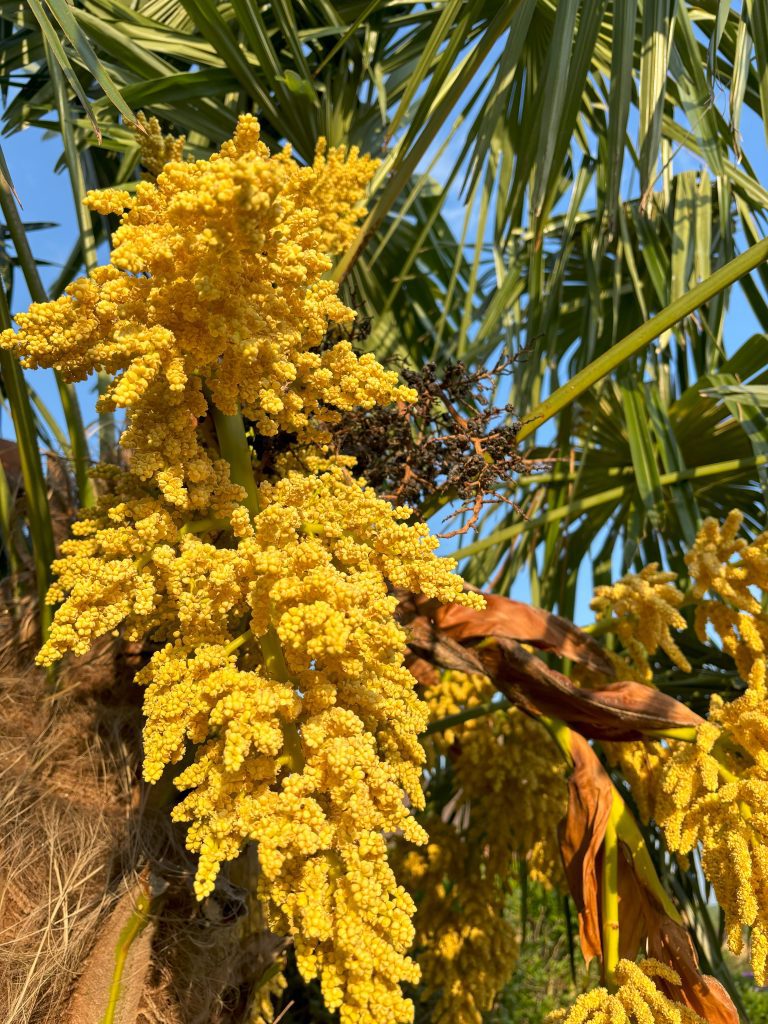Trachycarpus fortunei, commonly known as the Windmill Palm or Chusan Palm, is a versatile and resilient addition to gardens, especially those in the United Kingdom seeking a touch of the tropics. Despite its exotic appearance, this palm is well-suited to the UK climate, making it a popular choice for gardeners looking to create a lush, tropical ambiance.
Relevance to a UK Tropical Garden
Trachycarpus fortunei is an excellent choice for UK gardens due to its exceptional cold hardiness. This palm can withstand temperatures as low as -15°C (5°F), making it one of the most cold-tolerant palms available. Its ability to thrive in cooler climates while maintaining its striking tropical aesthetic makes it an ideal candidate for UK gardens. The fan-shaped leaves and fibrous trunk add architectural interest and a dramatic flair to garden landscapes, patios, and urban environments.
Size and Growth
Trachycarpus fortunei can grow up to 12-20 meters (40-65 feet) in height, with a trunk diameter of about 15-30 centimeters (6-12 inches). However, in the UK, it typically reaches a more modest height of around 6-8 meters (20-26 feet). The growth rate is relatively slow, often taking several years to reach significant heights. The large, palmate leaves can spread up to 2.5 meters (8 feet) across, providing ample shade and a lush, tropical canopy.
Growing Conditions
This palm thrives in well-drained soil, enriched with organic matter. It prefers a sunny or partially shaded location, though it can tolerate full shade. Windmill palms are quite adaptable, growing well in both coastal areas and inland gardens. Regular watering is essential, especially during dry periods, to maintain healthy growth. Mulching around the base can help retain moisture and protect the roots during colder months.
While Trachycarpus fortunei can tolerate clay soil, it is crucial to ensure that the soil is well-drained. Heavy clay soil can retain too much water, leading to root rot. Improving drainage by amending the clay soil with organic matter, sand, or grit can enhance the palm’s ability to thrive.
Sun Exposure
Trachycarpus fortunei can tolerate full sun and partial shade. In the UK, where intense heat is less common, planting in full sun is generally safe and can promote vigorous growth and a more robust appearance. However, in regions with harsher sunlight or during hot summer days, providing some shade during the peak afternoon hours can prevent leaf scorch.
Seeds and Flowers
Trachycarpus fortunei produces small, yellow flowers in dense, branched clusters, typically blooming in late spring to early summer. These flowers are followed by bluish-black drupes containing seeds. The flowers are dioecious, meaning that male and female flowers grow on separate plants. To produce seeds, both male and female palms need to be in proximity for cross-pollination.

Propagation
Propagation of Trachycarpus fortunei is primarily done through seeds. To propagate, follow these steps:
- Seed Collection: Collect ripe seeds from a mature female palm. Seeds should be cleaned of any fruit pulp to prevent mold.
- Seed Soaking: Soak the seeds in warm water for 24-48 hours to soften the seed coat and improve germination rates.
- Sowing: Sow the seeds in a well-draining seed compost, lightly covering them with soil. Maintain a warm temperature of around 25°C (77°F) for optimal germination.
- Germination: Seeds typically germinate within 1-3 months. Keep the soil moist but not waterlogged during this period.
- Transplanting: Once seedlings have developed a few leaves, they can be transplanted into individual pots. Gradually acclimate them to outdoor conditions before planting them in their final garden location.
Care and Maintenance
To ensure the health and vitality of Trachycarpus fortunei, regular care and maintenance are necessary:
- Watering: Keep the soil consistently moist but avoid waterlogging, which can lead to root rot.
- Feeding: Apply a balanced, slow-release fertilizer in spring to support growth and flowering.
- Pruning: Remove dead or damaged leaves to maintain a tidy appearance and improve air circulation around the plant.
- Winter Protection: In colder regions, protect the trunk and crown with horticultural fleece or burlap during severe frost spells.
Conclusion
Trachycarpus fortunei is a remarkable palm that brings a tropical feel to UK gardens with its striking appearance and impressive resilience. Its adaptability to cooler climates, tolerance of various soil types including clay (with proper drainage), and ability to thrive in both sun and partial shade make it a cherished addition for gardeners aiming to create an exotic oasis. With proper care and attention, the Windmill Palm can thrive and become a standout feature in any landscape.

